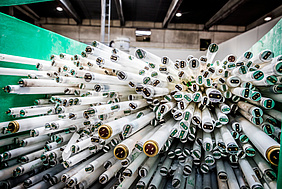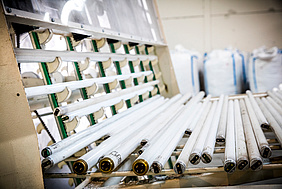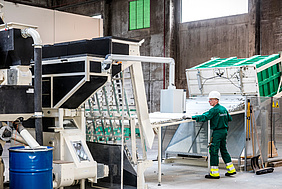IndaTube: your lamps, recycled better and more safely
Double the number of lamps treated
At Indaver's site in Doel, Indaver Relight treats 30 million mercury lamps each year, including all of the lamps collected in Belgium. This applies to fluorescent lamps, energy-saving lamps and other gas-discharge lamps. With IndaTube's predecessor, the roller crusher, Indaver was achieving a volume of 1,300 tons of treated fluorescent lamps. With IndaTube, Indaver will be able to reach 2,500 tons, which is almost double.
More efficient recovery
Indaver recovers the fluorescence powder, the lime glass – the glass from the fluorescent tube – and the caps from the lamps for re-use. With IndaTube they can remove the fluorescence powder more efficiently and remove as many (environmental) pollutants as possible from the fractions. We ensure the lime glass is ready to be sent back to the lamp manufacturers who use this glass to make new lamps. The fluorescence powder is sold; Rare earth metals are recovered from these powders; and the caps go back into the metal processing circuit. Hence this is a great example of closing the loop.
Working more Ergonomically
To achieve our ambitious processing figures, the lamps supplied also need to be sorted before they get to the IndaTube plant. Sorting the lamps is necessary due to the varying quality of the lamps supplied. Great care has therefore been taken over the construction of 4 new sorting points, which have been developed so that staff can sort larger volumes more ergonomically.
Less Environmental Impact from Mercury
These lamps contain a small amount of mercury, a volatile metal that is harmful to people and the environment. Environmentally safe treatment is therefore essential. European legislation regarding the impact from residual mercury is becoming increasingly strict. With IndaTube, we can keep the mercury concentrations in the fractions structurally below the newer and stricter European limits. The mercury is evaporated and converted into gaseous mercury in the IndaTube oven. All process air passes through an activated carbon filter which traps the mercury.
Recycling of lamps is a good example of the closed loop. Indaver wants to bring waste back into the materials chain as much as possible. In a circular economy materials that are recovered from waste streams are reintroduced as high-quality raw materials for their original purpose, or to make new products.
Share this page




